Click on images to enlarge
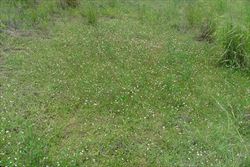
infestation (Photo: Sheldon Navie)
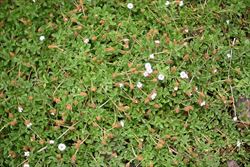
infestation (Photo: Sheldon Navie)
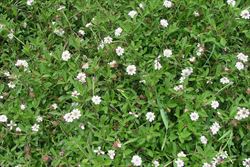
habit in flower (Photo: Sheldon Navie)
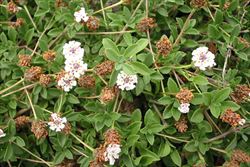
habit in fruit (Photo: Sheldon Navie)
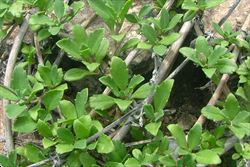
older woody stems and leaves (Photo: Sheldon Navie)
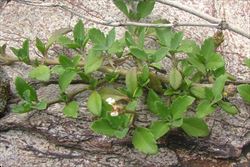
creeping stems (Photo: Sheldon Navie)
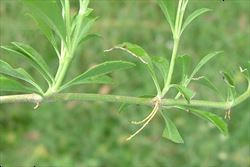
younger stem showing rooting at the joints (Photo: Sheldon Navie)

leaves (Photo: Sheldon Navie)
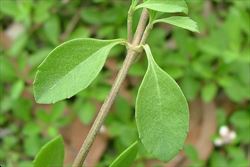
close-up of stem and paired leaves (Photo: Sheldon Navie)
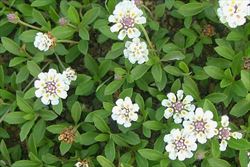
flower clusters (Photo: Sheldon Navie)
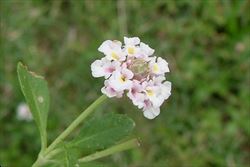
close-up of flowers (Photo: Sheldon Navie)
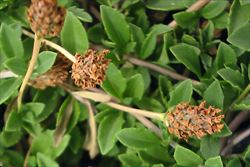
clusters of immature fruit (Photo: Sheldon Navie)
Scientific Name
Phyla canescens (Kunth) Greene
Synonyms
Lippia canescens KunthLippia nodiflora (L.) Michx. (misapplied)Lippia nodiflora (L.) Michx. forma canescens (Kunth) KuntzeLippia nodiflora (L.) Michx. var. repens (Bertol.) Schauer (misapplied)Lippia nodiflora (L.) Michx. var. rosea (D.Don) J.F. Macbr.Lippia nodiflora (L.) Michx. var. sarmentosa (Willd.) Schauer (misapplied)Phyla nodiflora (L.) Greene (misapplied)Phyla nodiflora (L.) Greene var. canescens (Kunth) MoldenkePhyla nodiflora (L.) Greene var. rosea (D. Don) MoldenkeZapania canescens (Kunth) GilbertZapania nodiflora (L.) Lam. var. rosea D. Don
Family
Verbenaceae
Common Names
carpet weed, Condamine couch, Condamine curse, fog fruit, fog-fruit, fogfruit, frog fruit, hairy fogfruit, lippia, mat grass, no-mow grass
Origin
Native to South America (i.e. Bolivia, southern Ecuador, western Peru, Argentina, Chile, Paraguay and Uruguay).
Cultivation
This species has been cultivated as a garden ornamental and as a low-maintenance lawn, particularly in the inland regions of Australia. It has also been used to stabilise soil and prevent erosion on banks of irrigation canals and around weirs.
Naturalised Distribution
Widely naturalised in south-eastern and eastern Australia (i.e. in southern Queensland, New South Wales, Victoria and south-eastern South Australia). Also occasionally naturalised in other parts of Queensland and in the inland regions of south-western and southern Western Australia.
Habitat
Predominantly a weed of pastures, grasslands, waterways and roadsides in semi-arid, sub-tropical and warmer temperate environments, but also grown in lawns and gardens.
Habit
A long-lived (i.e. perennial), creeping (i.e. prostrate) herbaceous plant with stems up to 1 m in length that form a dense mat over the ground surface.
Distinguishing Features
- a long-lived creeping herbaceous plant usually forming a dense mat over the ground surface.
- its small leaves (10-70 mm long and 4-25 mm wide) are oppositely arranged and usually have finely toothed margins.
- these leaves are somewhat fleshy and greyish-green in colour.
- its flowers are borne in small, dense, rounded clusters (5-10 mm across) on stalks emanating from the leaf forks.
- individual flowers are tubular (2-2.5 mm across) and whitish, pinkish, lilac or purplish in colour, with yellowish centres.
- its small, dry, fruit are enclosed in the old flower parts and split into two 'seeds' (about 2 mm long) when mature.
Stems and Leaves
The much-branched creeping (i.e. prostrate) stems readily produce roots (i.e. adventitious roots) at their joints (i.e. nodes). Young stems (2-3 mm thick) may appear hairless (i.e. glabrous) but are usually covered in tiny close-lying (i.e. appressed) hairs. They are either green in colour or have a reddish or brownish tinge. Older stems turn greyish in colour and can become somewhat woody with age.
The leaves are borne in pairs along the stems and have bluntly toothed (i.e. crenate), or rarely entire, margins. These leaves are somewhat fleshy (i.e. semi-succulent) and are borne on short stalks (i.e. petioles) 1-8 mm long. They are relatively small (10-70 mm long and 4-25 mm wide), greyish-green in colour and either hairless (i.e. glabrous) or covered in minute close-lying (i.e. appressed) hairs.
Flowers and Fruit
The flowers are borne in small, dense, rounded clusters (5-10 mm across) that elongate slightly with age (10-25 mm long). These flower clusters are borne on stalks (i.e. peduncles) 1-11 cm long emanating from the leaf forks (i.e. axils). Individual flowers are tubular in shape (2-2.5 mm across) with five inconspicuous lobes and are whitish, pinkish, lilac or purplish in colour, with yellowish centres. The inner flower buds are darker in colour than the open flowers. Flowering occurs throughout most of the year, and is particularly apparent when soil moisture is most favourable.
The small, dry, fruit (about 2 mm long and 1-1.5 mm across) are enclosed in the old flower parts (i.e. calyx). They split into two brown one-seeded segments (i.e. pyrenes or mericarps) when mature.
Reproduction and Dispersal
This species reproduces vegetatively via stem fragments as well as by seed.
Stem fragments and seeds are spread during floods and by other soil disturbances. Dispersal of this species has also been aided by its use as a low-maintenance lawn in some areas.
Environmental Impact
Lippia (Phyla canescens) is regarded as a serious environmental weed in New South Wales and Queensland. It was also recently listed as a priority environmental weed in six Natural Resource Management regions.
Legislation
This species is declared under legislation in the following states and territories:
- New South Wales: Class 4 - a locally controlled weed. The growth and spread of this species must be controlled according to the measures specified in a management plan published by the local control authority and the plant may not be sold, propagated or knowingly distributed (in the Gunnedah, Liverpool Plains, Moree Plains and Tamworth local authority areas).
- Western Australia: Unassessed - this species is declared in other states or territories and is prohibited until assessed via a weed risk assessment (throughout the entire state).
Management
For information on the management of this species see the following resources:
- the Biosecurity Queensland Pest Status Review on this species, which is available online at http://www.dpi.qld.gov.au.
- the New South Wales Department of Primary Industries Agnote on this species, which is available online at http://www.dpi.nsw.gov.au.
Similar Species
Lippia (Phyla canescens) is very similar to carpet weed (Phyla nodiflora). These two species are very difficult to distinguish, except by the different habitats they are usually found in:
- lippia (Phyla canescens) is found mostly in wetter inland habitats on clay soils. Its leaves are usually greyish-green with very short teeth and its flowers are usually lilac or pinkish in colour.
- carpet weed (Phyla nodiflora) is found mostly in more humid coastal areas on sandy soils. Its leaves are usually dark green with obvious teeth and its flowers are usually whitish in colour.

